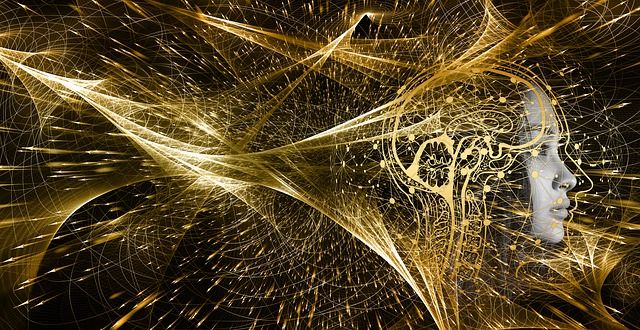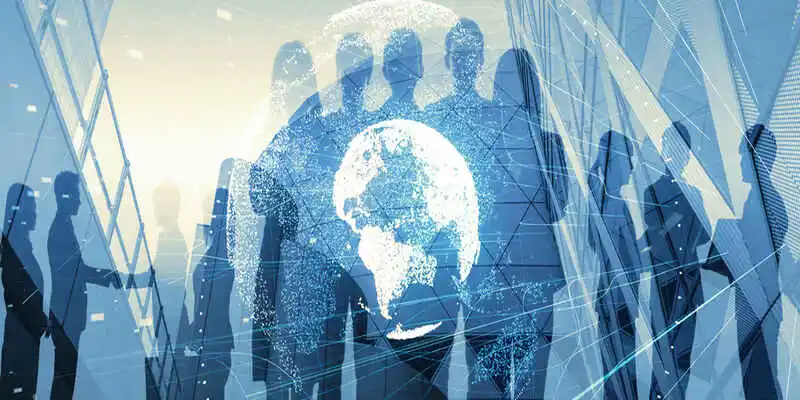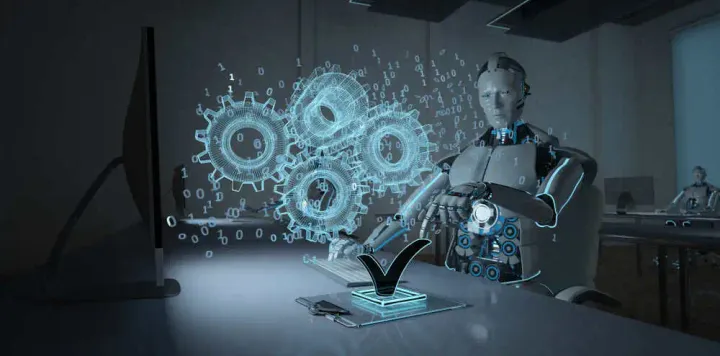Top 5 AI Achievements of 2020
AI has made significant progress in 2020, world has celebrated many AI accomplishments in NLP, Computer Vision and Robotics. Top AI achievements in 2020 involve improvements in automatic text generation, facial & speech recognition, detecting motion gestures, drug discovery & quantum supremacy.

Indeed, artificial intelligence (AI), machine learning (ML), deep neural learning, and data science have turned out to be life-changing technologies over the last decade. As we are approaching the end of the year, there is no doubt that year 2020 has been a very challenging and dark year due to pandemic crises. Numerous businesses endured disappointments during COVID-19, while it additionally delivered multiple champs rising in the wreck. Beauhurst in the UK wrote in a story that says 27% of AI-based startups are positively affected by the pandemic, whereas 22% of AI businesses are witnessing a rise in demand for resources. IDC precited that expenditures will exceed $49.2 billion to make Artificial Intelligence more robust than ever in 2020, and AI will help generate revenues up to $22 billion in the year 2020, according to Statista. AI is at the forefront of innovations, and by the end of 2027, the market size of AI will reach $266.92 billion with a 33.2% Compound Annual Growth Rate (CARG). Many organizations are already working with AI and have improved their customer services, including better customer experience, high quality, and productivity.

AI provides extraordinary solutions to every field and every company; it has also changed the landscape of health, living, learning, and other daily dealings. The most exciting development occurs in the computer vision space regarding self-driving vehicles. There has been a tremendous development of Tesla's level 5 autonomous vehicle in 2020 by Elon Musk. It would be a great deal for other related startups and companies supporting it.
Despite pandemic crises, one area that has been an element of excitement is the achievements in Artificial Intelligence. Companies and researchers have made significant progress and celebrated many AL/ML accomplishments especially in the field NLP, Computer Vision and Robotics. Top AI achievements in 2020 involve improvements in automatic text generation and translation, facial and sound recognition, detecting motion gestures, drug discovery, quantum supremacy and many more.
Let's have a look at top five most amazing achievements of Artificial Intelligence in year 2020.
1. GPT-3 – The Biggest Achievement of NLP: The Language of AI
The interaction between natural human languages and machines is a problem of natural language processing (NLP). In particular, how computers can be designed to process and analyze large volumes of natural language data. To this date, language processing has merged both conventional and convolutional neural networks for developing more advanced NLP models. The concepts of self-attention, transformers, and word embedding are gathered to create a relationship among words in parallel CNNS to understand complete corpora.
These AI-based language generative models can be pre-trained during the generative pre-training phase using a huge and diverse corpus of text datasets accompanied by many fine-tuned conditional models. These advanced training have removed the need for human supervision and time-intensive hand-labeling.
The publication of Google's BERT system accelerated advanced natural language processing (NLP) techniques. The model comes with an extraordinary NLP network that allows understanding languages more sophisticated and compatible. The given Google AI model is widely spread and open for public use. The BERT and the GPT-2 frameworks are used for the successful implementation of these concepts. However, every network works differently; both have introduced an ultra-deep transformer model to do multi-task objectives with accuracy.
A philosophically trained GPT-2 created a quote:
"The meaning of life is to create the illusion of possibility for those who lack this ability"
AI's language has become the perfect solution for language translation with the tremendous application of BERT and GPT-2. People now talk to the members of other communities with the language of AI Middleware. However, many devices evolved during 2019 regarding translating languages, but in 2020, they have become more accurate and reliable.
Earlier this year, Microsoft announce Turing Natural Language Generation (T-NLG), which was an enormous model with 17 billion parameters and improved performance compared to other language models in many areas, which include generating summarized text and Q&A.
In May 2020, OpenAI an AI research laboratory in San Francisco, and the developer of this GPT-n series released GPT-3 as a beta. GPT-3 is the largest AI-based pre-trained language model ever produced with 175 billion machine learning parameters. GPT-3 is, without a doubt, the biggest accomplishment in the domain of NLP so far. The nature of the content produced by GPT-3 is high to such an extent that it is hard to recognize from that composed by a human.
What GPT-3 can do?
GPT-3 is capable of producing high-quality text with the assistance of AI. The AI written article is fantastic enough and couldn’t be distinguished from that reported by humans. An Australian philosopher, David Chalmers, said that GPT-3 is one of the most outstanding and excellent AI discovery ever used by humans.
Unluckily, this AI-system has both benefits and risks as it can harm and threaten humans. The researchers and scientists at OpenAI mentioned in their paper the potential danger and aware users about severe risks. But Microsoft announced to control the source code in September 2020; it will allow users to deal with public API for receiving the output.
How people are using GPT-3 at the moment?
- Andrew Mayne used it for the AI Writer application, which creates hypothetical correspondence with historical personalities. The given AI-system is expert for both real and fictitious characters.
- Further, Jason Rohrer used this GPT-3 technology in December related to the retro-themed chatbot project. It allows the user to talk online with several AI systems.
- AI Dungeon is another application of GPT-3, which is involved in developing adventure games based on text.
2. AI-Enabled Healthcare and Drug Discovery
AI-based advancements in healthcare are one of the most beneficial uses of AI to mankind as it comes with offering speedy treatment strategies. For instance, InSilico Medicine developed a new potential drug with researchers from the University of Toronto; that particular drug can prevent tissue scarring in forty-six days only. Furthermore, it requires ten years to develop potential medications with an average cost of $2.6 billion, but AI promises to do the same task in less time and less budget.
Read more on How AI is helping in combating Coronavirus
COVID-19 Detection in Lungs by AI
The scientists at the University of Central Florida conducted a study to use artificial intelligence in the detection of COVID-19 in the lungs. The present study is efficient enough to lessen the testing challenges as the system is as accurate as a specialist medical doctor. They trained AI algorithms to identify COVID-19 pneumonia with ninety percent accuracy via computer tomography (CT) scans. It has identified 84 percent positive and 93 percent negative cases at present.
Effective Lung Cancer Diagnosis
In 2020, there are many other diseases to be considered in addition to COVID-19. For example, lung cancer is one of the most common disorders that has been spread worldwide. According to the World Health Organization (WHO), lung cancer has caused 9.6 million deaths in 2018. But if the disease is timely diagnosed, the doctors can now recover the patient with advanced technologies. There are several machines discovered for lung cancer diagnosis, which are becoming perfect with time. Some of them are:
- X-ray
- CT Scan
- Sputum Test
- Biopsy (expensive, painful, and complicated method)
- Other Scanning Techniques
AI made the process more accurate, accessible, cost-effective, and quick. This project's significance was seen in 2019 by researchers from Google AI, Northwestern Medicine, and Chicago. The scientists' trained an AI system with 42,290 CT lung scanned images from 14,851 lung cancer patients before starting the project. The striking thing about this project was its efficiency to check 500 photos in just ten minutes. Moreover, the AI-powered app reduced false results by eleven percent. In the future, AI will reduce the cost of a particular operation and the disease acquiring rate.
Brain Aneurysms Treatment with Robot
In 2020, the Canadian Surgeons developed a robot to treat brain aneurysms with high precision. Their robotic system is expert at dealing with neurovascular procedures. It can accommodate guidewires, microcatheters, and other electrical devices with software and hardware adaptations. Plus, this model offers a more precise fine-motor control system than the previous model.
Drug Discovery
COVID-19 was a recent disaster that required the rapid discovery of new medicine or vaccine to treat coronavirus attack. The discovery process of a new drug is time-consuming, complicated, and costly that consists of several stages from hypothesis to optimization. There is always a chance of unexpected results occurring during drug discovery and repeating the process from the start with a new way. Automation is the best solution that reshapes the entire process of drug development; AI combined effect with robotics, automatic data analysis, and microfluidics increased laboratory efficiency.
So, the AI-powered systems are helping in various ways involved to assist drug discovery process as:
- It comes with high-throughput and excellent screening databases that have enough information for drug discovery.
- Process automation helps in testing a large number of hypotheses in reduced time for fast and efficient results.
- Plus, robotics helps in providing improved responses regarding accuracy and reproductivity.
- It also involves predicting possible side effects of a particular drug and offer ways to minimize negative impacts.
AlphaFold - A Breakthrough in Solving Protein Structures
Google’s DeepMind AI, developed a deep-learning program called AlphaFold that has outdone many other teams in a biennial protein-structure prediction challenge Critical Assessment of Structure Prediction (CASP). DeepMind's CASP was able to detect how proteins fold up using AI 'AlphaFold', marking a significant breakthrough.
The program aims to determine the 3D shapes of proteins from its amino-acid sequence. It's an enormous milestone, a solution to 50-year-old grand challenge in the history of biology. The outcomes were declared on 30 November this year.
3. Graphics, Animation, Image, and Video Processing
Speech Recognition
It's entirely feasible to use voice commands when dealing with Google Assistance, Alexa, Microsoft Cortana, Siri, and many other virtual assistants. It is expected that this market will grow further and reach $3.505 million by 2024 and approach a CAGR of 23.89 percent. Major social media giants like Facebook, Google, Apple, Amazon, and Microsoft offer features to automate daily-life tasks. Plus, they are also providing the facility to search, translate, interact, and even control other IoTs (Internet of Things).
Speech recognition is evolved in 2020 with more accuracy and remarkable user experience. It has some challenges to surpass for delivering exceptional speech recognition service:
- To access different accents of humans
- Particular terms
- Enhance clarity in identifying a specific word
- Minimizing the effect of low recording device
- Reducing background noise
Video Analysis and Computer Vision
Advancement in artificial intelligence and deep learning made a video or image analysis more feasible with cheaper investment. Much medical equipment in the field of radiology has crossed human efficiency to diagnose certain diseases. These techniques are helping physicians in their daily patient-checkups by making them accurate and quick. Computer vision technologies are greatly influencing the manufacturing industry in offering automatic quality control and safety management techniques.
Face Recognition
Image processing and pattern recognition are one of the significant achievements of AI in 2020. Now every smartphone user is familiar with AI and its applications in recognizing face identity. Moreover, screen locks with face detection are also using strong AI that scans face for security purposes. AI face identification can be well-observed by Facebook detection and Google image search to recognize objects and faces.
AI involved in Making Blurry Faces Sharper
Artificial Intelligence increased the sharpness of blurry faces up to 60 percent with the advancement in technology. The given tool converts blurry pictures to computer-generated portraits. The researchers at Duke University worked to create faces that look real with 64 times resolution.
Fake Face Generation AI System
Many companies are making fake faces and selling them to other individuals or organizations for money. The organizations use these artificial humans to make their website well-known or as video game characters. Moreover, one can also get free faces and adjust their features (age, look, color) on the ThisPersonDoesNotExist.com website.
A company, Rosebud.AI, produced AI-generated humans with virtual talent, and they can even talk like real humans. Unfortunately, this technology has more malicious use than positive as fraud companies use it for harassing people. It will ultimately lead to lowering human integrity and destruction.
4. Motion and Gestures
Robots Grasping and Moving Objects
COVID-19 has shifted people to digital shopping from physically going to bazaars for preventive measures. Meanwhile, retailers need to deliver orders by considering the safety of their employees. It led to the development of robots with high speed and skill to assist human employees in warehouses.
The researchers at the University of California, Berkley, developed this software to grasp and move objects smoothly. In warehouses, most of the tasks need human assistance and makes it challenging to automate this process. An object's movement from one place to another requires coordination in the direction of arms, shoulders, and wrist. But this job is tough for a robot as its movement might be jerky and can damage the product and the robot itself. The senior author of the study, Ken Goldberg, stated that:
“Warehouses are still operated by humans primarily because it’s hard for robots to grasp different objects”
In their earlier teamwork, they introduced a Grasp-Optimized Motion Planner to help robots pick and move objects. But its motion was jerky, and changes were made to make movements smoother. They introduced neural networks to robots, which help them learn, and then they were assigned a particular object moving job. The team combined neural network and motion planner and reached average computing to 80 milliseconds from 29 seconds. It's an exciting achievement of AI in 2020 that's helping humans significantly.
Recognition of Hand Gesture
The given system uses skin-like electronics and computer vision to recognize hand gestures via artificial intelligence. The scientists of Nanyang Technological University (NTU), Singapore, are the developers of this unique system. The recognition of hand gesture system is made to use in monitoring medical instruments, surgical departments, and gaming systems. The developed method was visual-only initially, and researchers improved it by introducing several integrating inputs. They used a data fusion approach where the wearable sensor can redevelop the skin's sensing ability (somatosensory).
The NTU researchers generated a bioinspired data fusion system by using stretchable strain sensors like skin and AI. Carbon nanotubes are used to make sensors, while AI helped handle (sensing and visualizing) processes in the brain. They combined the effect of three neural networks to get extraordinary results in recognizing hand gestures.
- Convolutional Neural Network: it involves an initial visual processing method.
- Multilayer Neural Network: it involves processing initial somatosensory information.
- Spare Neural Network involves the fusion of those as mentioned above (visual and somatosensory) information.
It comes with high accuracy in recognizing even in poor background conditions. The NTU researchers are now finding ways to introduce a VR and AR artificial system in the entertainment and rehabilitation industry where high precision is the demand.
5. Processing Power: NVIDIA AI Accomplishment
Processing power is an area of great significance for training complex models that require extensive computational power. At the end of last year, Google has accomplished Quantum Supremacy. In July 2020, NVIDIA has achieved a record-breaking milestone. According to the MLPerf benchmarks, NVIDIA is the world's fastest AI training performance provider in commercial products. The A100 Tensor Core GPU is a practical example of its most rapid performance project per accelerator on 8 MLPerf benchmarks. The researchers joined the DGX SuperPOD System with HDR InfiniBand to achieve the overall fastest performance solution; the system set eight unique performance marks. The business-persons are applying this system to speed-up their organizational programs with cost-effective AI techniques.
Read more on How AI can be used to reduce business cost
The MLPerf is an industry performance evaluating group founded in 2018, and NVIDIA secured six world-class records in 2018 and eight in 2019. NVIDIA made records in providing customers with comfort with high-quality commercial products. Many other companies are trying to compete with NVIDIA, but their effects will take several months to be available for use. It helps social giants provide cloud services, including Baidu Cloud, Amazon Web Services, Microsoft Azure, and Tencent Cloud. Users from the globe apply A100 to deal with complex challenges with AI, computing, and data science solutions.
People are using this technology to find treatment for COVID-19 or developing a new recommendation. At the same time, others are using it for conversational artificial intelligence applications. HDR InfiniBand provides deep learning engines with SHARP (scalable hierarchical aggregation and reduction potential) technology. Above all, NVIDIA offers an exceptional solution in recommendation systems, reinforced learning, and conversational AI.
In 2019, a quantum processor was used to perform computational tasks via quantum computers that work exceptionally faster than a classical processor. The scientists developed a highly-reliable processor to run the complex quantum algorithm in a large enough computational space. They used a processor with superconducting qubits and created quantum states on 53 qubits.
Interesting Mentions
1) Robot Self Repair: Now, robots will use artificial intelligence to sense pain and respond to it by self-repairing it. The researchers at Nanyang Technological University, Singapore, developed mini-brains that can recognize problems. They react to the pressure applied to them via external force.
2) Forecasting Heat Waves & Cold Spells: The researchers at Rice University used an advanced deep learning algorithm to develop a computer system. The system can predict weather changes, including hot and cold environments up to five days based on current weather conditions with 85 percent accuracy.
3) Skin-like Sensors: The scientists at the University of Toronto Faculty of Applied Science & Engineering experimented with developing human skin-like sensors. They produced a flexible, transparent, and self-powering sensor that learned complex human skin sensations. The development of AISkin will improve the conditions of electronics, robotics, and the health industry.
Significant Changes to Notice in 2020
There have been many positive and some bad news related to AI in 2020. Usually, bad news gets more attention than good ones. Now, AI can predict changes in the surrounding environment as it comes with a new set of data to analyze and integrate information. For instance, AI is trained to detect faces wearing masks; it identifies the face's upper part. It means that AI is now smart enough to detect surrounding changes.
The vice president at Pactera Edge, IT Consulting Company, Sharms said:
“It was never trained on a spike like this, so the system was out of whacks”
Another example is a massive change in different term searches on search engines. In a few days, the most common searches like chargers, phone cases, LEGO, and many others are replaced by COVID-19 term. It means that the norm in 2019 is different in 2020, giving birth to new case studies and algorithms.
Issues in Finding and Labeling Visual Data
AI can perform tasks in minutes that could take years to be done by humans. A significant amount of visual data processing and labeling is required for the proper functioning of computer vision. However, most of that data comes from manual work of going into the place of interest and then taking pictures. In 2020, as most of the areas were blocked and locked, it reduced potential datasets available due to restricted access to specific regions for snap capturing.
AI helps search engines like Google to show relevant search results for a particular keyword. Google has to update its algorithm because of COVID-19 to ensure that the right information is shared with the public. Moreover, it should also be efficient to remove those results which are providing wrong or copy-pasted information.
Not every company has significant benefits of their investment in AI
The Boston Consulting Group and MIT surveyed almost 2500 leaders and found that every seven out of ten members said that their AI projects had generated little revenue so far. According to the PwC survey, the big giants fell from 27 percent to 18 percent who implemented AI in multiple areas.
Read more on Why AI projects Fail?
Pros and Cons of AI Applications
Pros
The good news related to AI are as follows:
- Outstanding AI applications related to healthcare in hospitals
- AI tools helping special people
- Robots helping in Agriculture
- Smart devices guiding people in solving daily queries
- High evolution, adaption, and AI-based research
Cons
Some of the popular bad news is as given below:
- AI involved in fake news generation
- Creating inappropriate fakes from media available on social platforms
- Autonomous vehicle killing a pedestrian
- Data biases causing issues in AI applications
- AI system attacking production facility
AI is still finding its way to boom the world
At the time of COVID-19, only a few industries can afford AI startups in their businesses to push technology further. There are varying subsets and forms of AI; some can do a mundane task whereas, others are excited to change the world. Moreover, some AI states are experiencing high demands while still, many others have to be explored to implement the businesses properly. Society needs to know about the roads developed by AI; so, they should be prepared for the worst and the best from AI. AI transforms face and speech recognition, drug discovery, virtual assistance, text generation, enhanced security, and many other departments. The technology is evolving with time to provide more robust and intelligent systems.
Some things were illusions a few years ago but now become a reality and helping humanity in real-time. Thanks to AI as it provided autonomous driving cars, smart houses, in-depth DNA analysis, and diagnosis of life-threatening diseases on time. Much advancement will come in approaching years that will fully automate daily tasks and facilitate living exceptionally.
Cheers :)
Full List of all significant Artificial Intelligence achievements in the history till date






